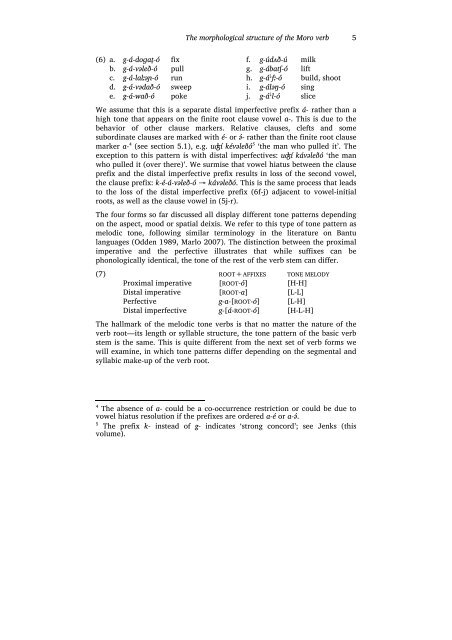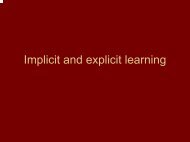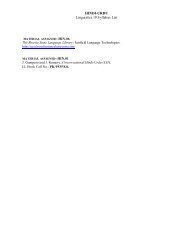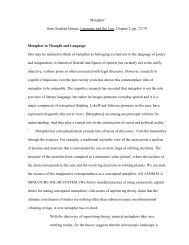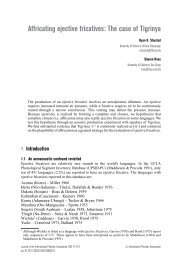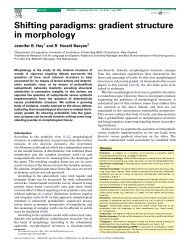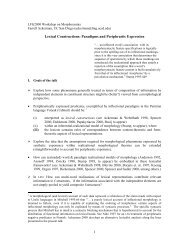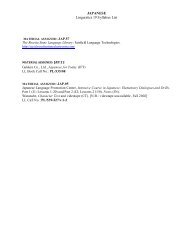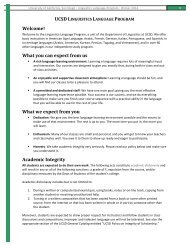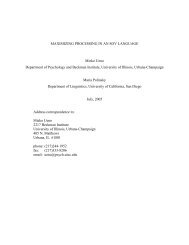The morphological structure of the Moro verb Sharon Rose
The morphological structure of the Moro verb Sharon Rose
The morphological structure of the Moro verb Sharon Rose
You also want an ePaper? Increase the reach of your titles
YUMPU automatically turns print PDFs into web optimized ePapers that Google loves.
<strong>The</strong> <strong>morphological</strong> <strong>structure</strong> <strong>of</strong> <strong>the</strong> <strong>Moro</strong> <strong>verb</strong><br />
(6) a. g-á-doɡat ̪-ó fix f. g-údʌð-ú milk<br />
b. g-á-vəleð-ó pull g. g-ábatʃ-ó lift<br />
c. g-á-lalːəɲ-ó run h. g-á ↓ fː-ó build, shoot<br />
d. g-á-vədað-ó sweep i. g-áləŋ-ó sing<br />
e. g-á-wað-ó poke j. g-á ↓ l-ó slice<br />
We assume that this is a separate distal imperfective prefix á- ra<strong>the</strong>r than a<br />
high tone that appears on <strong>the</strong> finite root clause vowel a-. This is due to <strong>the</strong><br />
behavior <strong>of</strong> o<strong>the</strong>r clause markers. Relative clauses, clefts and some<br />
subordinate clauses are marked with é- or ə́- ra<strong>the</strong>r than <strong>the</strong> finite root clause<br />
marker a- 4 (see section 5.1), e.g. uʤí kévəleðó 5 ‘<strong>the</strong> man who pulled it’. <strong>The</strong><br />
exception to this pattern is with distal imperfectives: uʤí kávəleðó ‘<strong>the</strong> man<br />
who pulled it (over <strong>the</strong>re)’. We surmise that vowel hiatus between <strong>the</strong> clause<br />
prefix and <strong>the</strong> distal imperfective prefix results in loss <strong>of</strong> <strong>the</strong> second vowel,<br />
<strong>the</strong> clause prefix: k-é-á-vəleð-ó → kávəleðó. This is <strong>the</strong> same process that leads<br />
to <strong>the</strong> loss <strong>of</strong> <strong>the</strong> distal imperfective prefix (6f-j) adjacent to vowel-initial<br />
roots, as well as <strong>the</strong> clause vowel in (5j-r).<br />
<strong>The</strong> four forms so far discussed all display different tone patterns depending<br />
on <strong>the</strong> aspect, mood or spatial deixis. We refer to this type <strong>of</strong> tone pattern as<br />
melodic tone, following similar terminology in <strong>the</strong> literature on Bantu<br />
languages (Odden 1989, Marlo 2007). <strong>The</strong> distinction between <strong>the</strong> proximal<br />
imperative and <strong>the</strong> perfective illustrates that while suffixes can be<br />
phonologically identical, <strong>the</strong> tone <strong>of</strong> <strong>the</strong> rest <strong>of</strong> <strong>the</strong> <strong>verb</strong> stem can differ.<br />
(7) ROOT+AFFIXES TONE MELODY<br />
Proximal imperative [ROOT-ó] [H-H]<br />
Distal imperative [ROOT-a] [L-L]<br />
Perfective g-a-[ROOT-ó] [L-H]<br />
Distal imperfective g-[á-ROOT-ó] [H-L-H]<br />
<strong>The</strong> hallmark <strong>of</strong> <strong>the</strong> melodic tone <strong>verb</strong>s is that no matter <strong>the</strong> nature <strong>of</strong> <strong>the</strong><br />
<strong>verb</strong> root—its length or syllable <strong>structure</strong>, <strong>the</strong> tone pattern <strong>of</strong> <strong>the</strong> basic <strong>verb</strong><br />
stem is <strong>the</strong> same. This is quite different from <strong>the</strong> next set <strong>of</strong> <strong>verb</strong> forms we<br />
will examine, in which tone patterns differ depending on <strong>the</strong> segmental and<br />
syllabic make-up <strong>of</strong> <strong>the</strong> <strong>verb</strong> root.<br />
4<br />
<strong>The</strong> absence <strong>of</strong> a- could be a co-occurrence restriction or could be due to<br />
vowel hiatus resolution if <strong>the</strong> prefixes are ordered a-é or a-ə́.<br />
5<br />
<strong>The</strong> prefix k- instead <strong>of</strong> g- indicates ‘strong concord’; see Jenks (this<br />
volume).<br />
5


